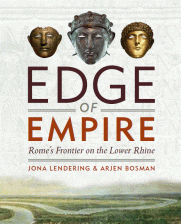
The Aufanian Mothers (Rheinisches Landesmuseum, Bonn)
In 1981, Ramsay MacMullen published his Paganism in the Roman Empire, a great book on, well, paganism in the Roman Empire. What I have never forgotten, is how the American scholar tried to investigate which gods were really popular. He used the indices of the Corpus Inscriptionum Latinarum, counted the deities to which people had dedicated inscriptions, and discovered that people in, for example, North Africa venerated other gods than the people in Gaul and the German provinces.
This tedious labor must have taken lots of time. Today, we have digital archives and can do the same job in one evening, for example with this nice databank. I know this, because I checked some thirty deities, trying to zoom in a bit more than MacMullen has been able to. One of his categories was “Gaul & Germany”, and I needed to know whether there were differences between Germania Inferior and Gallia Belgica. I compared my results to Latium (minus Rome). Here are the results; the popularity of the deities is relative to Jupiter (=100).
|
Latium |
|
Germania Inf. |
|
Belgica |
|
| 1 |
Mars |
194 |
Matres |
168 |
Mercurius |
139 |
| 2 |
Venus |
101 |
Jupiter |
100 |
Mars |
136 |
| 3 |
Jupiter |
100 |
Nehalennia |
67 |
Jupiter |
100 |
| 4 |
Fortuna |
92 |
Mercurius |
43 |
Liber Pater |
84 |
| 5 |
Hercules |
71 |
Mars |
37 |
Apollo |
52 |
| 6 |
Silvanus |
45 |
Hercules |
34 |
Hercules |
41 |
| 7 |
Diana |
44 |
Fortuna |
21 |
Sol/Mithras |
37 |
| 8 |
Sol/Mithras |
43 |
Juno |
16 |
Matres |
30 |
| 9 |
Victoria |
40 |
Diana |
16 |
Minerva |
19 |
| 10 |
Cybele |
36 |
Sol/Mithras |
16 |
Diana |
13 |
| 11 |
Juno |
30 |
Apollo |
11 |
Juno |
13 |
| 12 |
Ceres |
28 |
Minerva |
11 |
Fortuna |
8 |
| 13 |
Isis |
25 |
Isis |
8 |
Victoria |
8 |
| 14 |
Mercurius |
25 |
Silvanus |
8 |
Venus |
5 |
| 15 |
Apollo |
24 |
Victoria |
7 |
Silvanus |
3 |
I had expected that Jupiter and Mars would be the only gods to make it to the top-5 everywhere, but there were a few surprises. In the first place, the relative unpopularity of Isis, Minerva, and Neptune. In the second place, the popularity of Mercurius and Liber Pater in Belgica, who must be “romanized” local gods. In the third place, I had not expected that Silvanus -extremely popular in Italy- was also pretty well-known in the north. In the fourth place, I had expected Cybele to rank high in Germania Inferior and Belgica, because she is well-known from representations (statuettes can be seen in any museum); but this popularity is not matched in the epigraphical record.
Finally, the people of Latium were “wide” polytheists, venerating many gods, while the people of the north concentrated on a few deities. This was the greatest surprise – I had never realized that there might have been various degrees of polytheism.
And of course, what MacMullen already knew remains valid when we zoom in on smaller geographical units: that book on ancient mythology you have, you can throw it away. Those twelve Olympic Gods were completely irrelevant.




 Posted by Jona Lendering
Posted by Jona Lendering 
 Subscribe to feed
Subscribe to feed